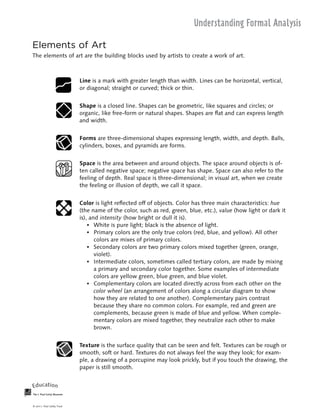Elements art
•
1 gefällt mir•342 views
The document discusses the key elements of art - line, shape, form, space, color, and texture. It defines each element and provides examples. Line is a mark with length and width that can be straight or curved. Shape is a closed line that can be geometric or organic. Form is a three-dimensional shape that expresses length, width and depth. Space refers to the area between objects or the feeling of depth. Color has characteristics of hue, value and intensity. Texture describes the surface quality that can be seen and felt.
Melden
Teilen
Melden
Teilen
Downloaden Sie, um offline zu lesen

Empfohlen
Empfohlen
Weitere ähnliche Inhalte
Was ist angesagt?
Was ist angesagt? (18)
Ähnlich wie Elements art
Ähnlich wie Elements art (20)
The Elements of Art Slideshow -Explaining All of the Elements

The Elements of Art Slideshow -Explaining All of the Elements
Bacic-Elements-of-Art-and-Principles-of-Design-PPT.pptx

Bacic-Elements-of-Art-and-Principles-of-Design-PPT.pptx
Mehr von Yogz John Mark
Mehr von Yogz John Mark (10)
Elements art
- 1. Education The J. Paul Getty Museum at the Getty Center Education The J. Paul Getty Museumpoint © 2011 J. Paul Getty Trust Understanding Formal Analysis 169 Performing Arts in Art © 2011 J. Paul Getty Trust Elements of Art The elements of art are the building blocks used by artists to create a work of art. Line is a mark with greater length than width. Lines can be horizontal, vertical, or diagonal; straight or curved; thick or thin. Shape is a closed line. Shapes can be geometric, like squares and circles; or organic, like free-form or natural shapes. Shapes are flat and can express length and width. Forms are three-dimensional shapes expressing length, width, and depth. Balls, cylinders, boxes, and pyramids are forms. Space is the area between and around objects. The space around objects is of- ten called negative space; negative space has shape. Space can also refer to the feeling of depth. Real space is three-dimensional; in visual art, when we create the feeling or illusion of depth, we call it space. Color is light reflected off of objects. Color has three main characteristics: hue (the name of the color, such as red, green, blue, etc.), value (how light or dark it is), and intensity (how bright or dull it is). • White is pure light; black is the absence of light. • Primary colors are the only true colors (red, blue, and yellow). All other colors are mixes of primary colors. • Secondary colors are two primary colors mixed together (green, orange, violet). • Intermediate colors, sometimes called tertiary colors, are made by mixing a primary and secondary color together. Some examples of intermediate colors are yellow green, blue green, and blue violet. • Complementary colors are located directly across from each other on the color wheel (an arrangement of colors along a circular diagram to show how they are related to one another). Complementary pairs contrast because they share no common colors. For example, red and green are complements, because green is made of blue and yellow. When comple- mentary colors are mixed together, they neutralize each other to make brown. Texture is the surface quality that can be seen and felt. Textures can be rough or smooth, soft or hard. Textures do not always feel the way they look; for exam- ple, a drawing of a porcupine may look prickly, but if you touch the drawing, the paper is still smooth.
